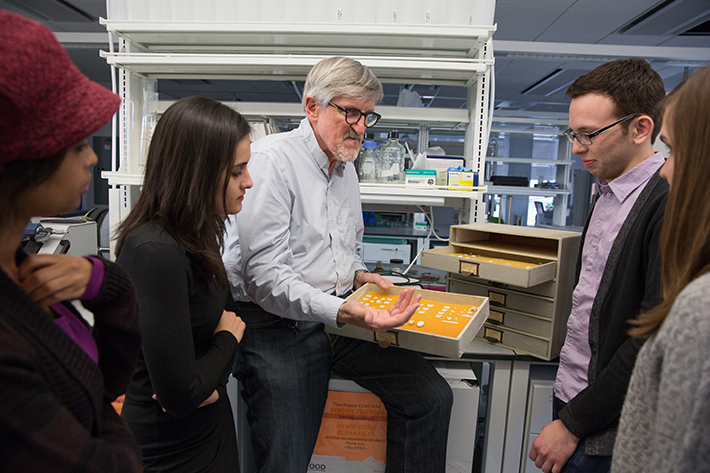This is the second profile in a GW Today series that features faculty from the Columbian College of Arts and Sciences and the School of Engineering and Applied Science who are conducting research with an impact in Science and Engineering Hall.
Two million years ago, unsightly creatures with small brains, massive teeth and wide, flat faces roamed the Turkana Basin in Northern Kenya. Though not a direct ancestor, the ape-like species, Paranthropus boisei, is linked more closely to humans than to bonobos and chimpanzees—our two closest living relatives.
“Would you ever have imagined that you had a close relative who looked like that?” asked Bernard Wood, University Professor of Human Origins at the George Washington University.
Up until the mid-20th century, the story of human evolution sounded fairly simple: Humans evolved, one after another, in a linear path that started with Australopithecus afarensis and ended with Homo sapiens. Experts suspected that all extinct human relatives were our direct ancestors (the equivalent of our very great, great grandparents).
Dr. Wood—a medical student turned paleoanthropologist and a leading expert in human evolution—was among the first researchers to argue that P. boisei inhabited East Africa at the same time as three other species of hominin, the group consisting of modern humans and our close extinct relatives.
This means that all but one of those species was not ancestral to modern humans. The others were our close relatives (similar to aunts or uncles).
“You can’t have three fossil ancestors living at the same time,” said Dr. Wood, the director of GW’s Center for the Advanced Study of Human Paleobiology housed in the Columbian College of Arts and Sciences.
In other words, human history did not resemble a single tree twig, but rather a tree with many tiny branches. Since that controversial revelation, scientists are still debating the origins of our genus.
Dr. Wood’s job is to decipher our direct ancestors from our close relatives in order to piece together the many different branches in the human family tree. He is particularly interested in what morphology can tell us about the branching pattern and how our prehistoric relatives behaved. How did they move around, use their hands and chew their food?
The evidence available to answer those questions, however, is scarce.
“It’s like trying to figure out what’s happened after a traffic accident when most of the cars have been destroyed,” Dr. Wood said. “There is a bit of a hood here, a fender there, a piece of upholstery, but not a complete seat.”
In his 50-year career as a paleoanthropologist—someone who studies the prehistoric human—Dr. Wood has remained skeptical that the narrative of human evolution is as simple as some might believe.
“Everyone assumes that walking on your hind limbs evolved only once, but we don’t know that,” Dr. Wood said.
Each year, as scientists uncover more fossils that fit into the human lineage, the story of our beginnings only becomes more complex. Dr. Wood predicts that there are, in fact, many more early hominin species waiting to be discovered.
This assures the paleoanthropologist, who bores easily, that he will never run out of puzzles to solve.
Off the Beaten Path
Much of what led Dr. Wood to studying human origins seemed to happen more or less by accident.
As a boy, he traveled by bicycle to deliver groceries from his parents’ store in England. The accountants and attorneys he delivered to were not especially kind or grateful, Dr. Wood said. But an amicable pair of physicians who lived at the top of a hill—a pediatrician and cardiologist—always invited him into their home for a glass of lemonade.
“I thought, well, these are decent people. I’ll do what they do,” Dr. Wood says. “That wasn’t a terribly compelling reason to do medicine.”
He attended medical school at the University of London where he took a course on human evolution. His instructor had a close relationship with Mary Leakey, one of the world’s most distinguished paleoanthropologists. In 1968, her son Richard Leakey, was preparing to lead an expedition in Northern Kenya’s Lake Turkana (then known as Lake Rudolf) to search for hominin fossils. Mary Leakey suggested Dr. Wood go with her son during his two-month elective period as a medical student.
As part of Dr. Leakey’s research team, Dr. Wood became immersed in the world of fossil hunting, as he helped uncover pieces of prehistoric history.
“In those days it was all a bit like Indiana Jones,” Dr. Wood said.
After that summer, Dr. Wood returned to England to complete his medical degree. He briefly practiced medicine before he was appointed as a lecturer at the Middlesex Hospital Medical School.
But his plans for a career as a surgeon were put on hold when Dr. Leakey invited Dr. Wood to become a member of the Koobi Fora Research Project, which is ongoing today. Dr. Leakey charged a three-man team with examining and describing hominin fossils uncovered at Lake Turkana.
The researchers could not decide among themselves who would identify which fossils, since all three were interested in studying the limb bones. To solve the dispute, a frustrated Dr. Leakey broke matches into different lengths and made the researchers draw. Dr. Wood, having pulled the shortest match, was stuck with the cranial and dental remains.
“It’s not what I particularly wanted to do, but I’m glad I did,” Dr. Wood said.
Over the next 16 years, Dr. Wood studied the Koobi Fora teeth and skull bones and all the similar fossils found in museums around the world. In addition to describing the cranial fossils, he also determined how many taxa were represented and organized all this information into a monograph, which was published in 1991.
In his results, Dr. Wood concluded that early fossils attributed to Homo habilis, which experts once believed was an ancestor of Homo erectus, more likely represented two species: Homo habilis sensu stricto and Homo rudolfensis. His hypothesis that two species of Homo lived at the same time challenged the traditional view that humans evolved in a single lineage.
Since then, researchers now are able to analyze fossils on a molecular level, using DNA. But understanding relationships among early hominins, for which genetic evidence does not exist, remains a challenge.
“The best way to find out how to do that in the past, is to work out how you can do it in the present,” Dr. Wood said.
Molecular evidence tells us that humans are more closely related to chimpanzees and bonobos than chimps and bonobos are related to gorillas.
“But go to any zoo, and you’d say that’s nonsense,” Dr. Wood said. “There appears to be a huge amount of physical evidence that shows that isn’t the case.”
Dr. Wood is interested in figuring out the implications of that anomaly to reconstruct relationships between organisms that are millions of years old.
“In other words,” he said, “can we learn any lessons from looking at great apes and modern humans that would allow us to work out relationships in the fossil record?”
A New Era of Human Paleobiology at GW
In 1995, Dr. Wood became dean of the medical school at the University of Liverpool, the same year that GW began a search for a professor of human origins, supported by the Henry R. Luce Foundation. The foundation enlisted Dr. Wood to advise about potential candidates, but when the search continued with no avail, the committee asked Dr. Wood if he would be interested in the position.
“I told them I didn’t have time for that. I was running a medical school, and by all accounts I was actually doing it well,” Dr. Wood said. “But, to be honest, some parts of my job were pretty boring.”
Dr. Wood was chairing a selection committee for a medical faculty position, when one “boring” candidate put him to sleep. When he awoke, he seemed to have a change of heart.
“I thought, ‘Is this really something I want to do for the rest of my life?’ Because clearly, some of it was not terribly exciting,” Dr. Wood said. “So in the end, I left being dean of medical school, and I came here.
When Dr. Wood arrived at GW, Professor Alison Brooks was one of the only faculty members studying paleoanthropology. Today, the Center for the Advanced Study of Human Paleobiology (CASHP) includes nine core GW faculty members, six researchers from the Smithsonian Institution, 10 postdoctoral scientists and 24 current graduate students.
The Paleobiology Ph.D. program was a trailblazer, according to Dr. Wood.
“Our graduate program is designed to prepare people to reduce our ignorance of human evolution,” Dr. Wood said. “Typically, these types of programs are housed in anthropology departments. Here, our students don’t study modern languages or cultural anthropology because it isn’t necessary.”
Instead, students take courses on geospatial analysis, molecular developmental biology and systematics.
While Dr. Wood’s research focuses on improving our ability to reconstruct hominin phylogeny, the research profile in CASHP is diverse, ranging from evolutionary neuroscience and primate genomics to social cognition and Stone Age archaeology.
These researchers were once scattered in multiple town houses throughout the Foggy Bottom Campus, where they may have gone days, or even weeks, without seeing one another.
In Science and Engineering Hall, Dr. Wood and his colleagues are overjoyed to finally share lab space next to one another. In the new building’s CASHP nook, complete with fossil models and a Foosball table, there is an atmosphere of excitement and camaraderie.
Accurately piecing together the history of humankind could have a host of potential applications. Understanding hominin diversity could, for instance, help biologists uncover the evolutionary pressures that led to it, such as climate change. And studying how our ancestors evolved could also help doctors to determine, for instance, how humans biologically adapt to infectious disease.
“But that’s not the reason I do it,” Dr. Wood said. “Why do you climb mountains? Because they’re there, and because it’s a difficult challenge.”



